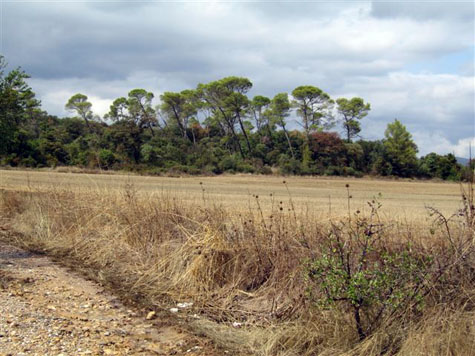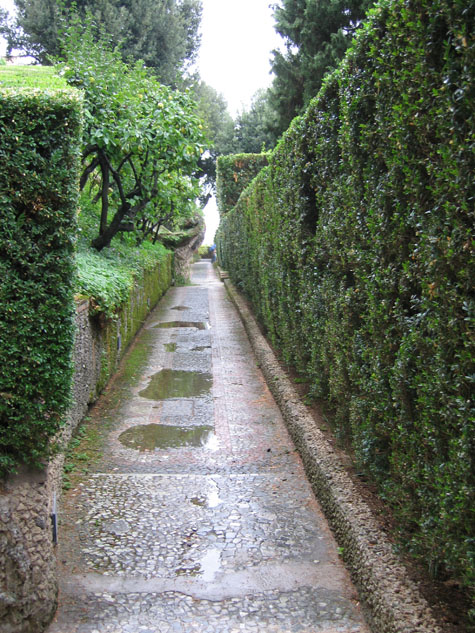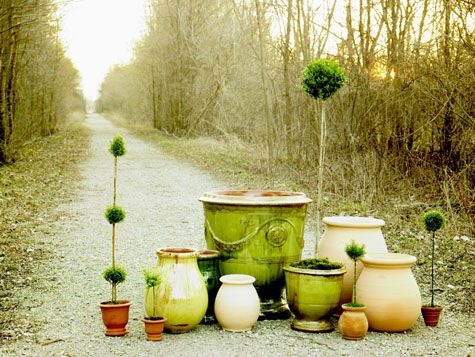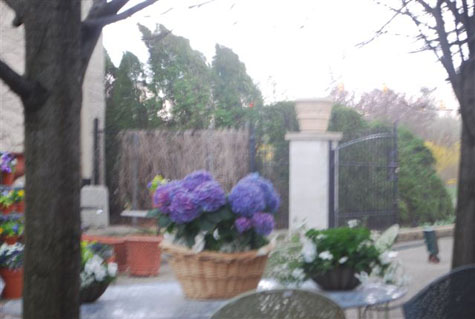 Earth, air, fire and water; the mythology is long and varied. My simple version: the sculpture, which is the earth, makes for life. No less important is air-every living thing breathes.
Earth, air, fire and water; the mythology is long and varied. My simple version: the sculpture, which is the earth, makes for life. No less important is air-every living thing breathes.

Air can be wind storms, or breezes. Air can be still and palpable; one remarkable things about fog is how still the air is. Air conditions influence the performance of a landscape as much as the earth. Frost, air laden with freezing water, sinks into low spots, and damages or kills plants. Air moving over water, off a lake, is intense air-whether we’re talking hot, cold, or strong. Hot winds dry out plants; cold winds make for winter burn. Wind is a force to be reckoned with-do you need a windbreak first off-so you can garden in peace?
We had big winds and 80 degrees, today-in April, for pete’s sake. We watered all day. The lettuces in my spring pots had that windblown look-it was not a good look. A straight line wind ripped the roof off my building a few years ago- in seconds. Wind makes very large buildings sway. Windy weather affects everything in a landscape-plan on it.
I cannot figure out how to take a picture of wind-I could only photograph the debris it picks up, the petals it scatters, the rain it drives sidesways. The unseen air can make for airy-loose and beautiful. Good air circulation is an enemy of mildew, and a friend to root development in all plants. Airy is the texture of some trees, where you might want a view through to a far landscape element. A breeze makes for that motion that makes a meadow so beautiful. Heavy foggy moody days soften the view and invite retrospection; a sharp crisp fall day is invigorating. Air at great speeds can make for hell on earth. I think this is a good description of nature- what you are least expecting, happening on a regular basis. Taking nature into account when you design, and when you plant, will help you be successful. I am interested in people being successful with their landscapes; who doesn’t enjoy what they apparently are good at? Some success makes the inevitable failures easier to bear. Sensational landscape design begins with an understanding and respect for the elements. A plant you really like, that requires protection from winter winds, will prosper from the companionship of a windbreak. Farmers plant windbreaks, maybe you need beautiful enclosure.






 I did the project pictured many years ago in central Indiana. My client built this house in the middle of 80 acres of farmland. He and his wife tithed the use of this land, to grow corn, to their church. The landscape became a farm, and the farm was a landscape. All of the woody material was planted in rows, as if they were crops. I designed a pattern of the planting of the corn perpendicular to the woody planting of the landscape, so as to connect this very large house to a large piece of ground. This many years before I ever learned about crop circles.
I did the project pictured many years ago in central Indiana. My client built this house in the middle of 80 acres of farmland. He and his wife tithed the use of this land, to grow corn, to their church. The landscape became a farm, and the farm was a landscape. All of the woody material was planted in rows, as if they were crops. I designed a pattern of the planting of the corn perpendicular to the woody planting of the landscape, so as to connect this very large house to a large piece of ground. This many years before I ever learned about crop circles.  I was especially happy with this landscape, as I was able to persuade my client to commit to a big idea, and use smaller material, so as to keep within their budget. Big houses need big ideas as much as small houses do. I have never been back to see the project, but I hope that it is all still there, sturdy and strong.
I was especially happy with this landscape, as I was able to persuade my client to commit to a big idea, and use smaller material, so as to keep within their budget. Big houses need big ideas as much as small houses do. I have never been back to see the project, but I hope that it is all still there, sturdy and strong.
 OK, I have spent days detailing my childhood exposure and love of dirt-how does this pertain to you? Sculpting ground-this is a fancy definition for “grading”. Grading dirt, simply stated, it is the process of moving dirt around, so water drains, there are flat places to be, and the sculpture of the ground which will become your landscape, looks interesting, and beautiful. We can lower the dirt here; we can raise the dirt here. We can feather that area into this one. How the house sits on the land is a big issue for new homes-thus many cities require grading plans. The project pictured tried to address a specific landscape issue. A giant bumpy lawn on a considerable slope was not hospitable to either my client, or her guests. The space needed some flat ground, and a sense of some intimacy. The lawn was greatly over scaled for people. Nor was the shape of the lawn beautiful. With an earthmover, and rakes, the ground became sculptural and beautiful-but also useable. I call this a grass amphitheater.
OK, I have spent days detailing my childhood exposure and love of dirt-how does this pertain to you? Sculpting ground-this is a fancy definition for “grading”. Grading dirt, simply stated, it is the process of moving dirt around, so water drains, there are flat places to be, and the sculpture of the ground which will become your landscape, looks interesting, and beautiful. We can lower the dirt here; we can raise the dirt here. We can feather that area into this one. How the house sits on the land is a big issue for new homes-thus many cities require grading plans. The project pictured tried to address a specific landscape issue. A giant bumpy lawn on a considerable slope was not hospitable to either my client, or her guests. The space needed some flat ground, and a sense of some intimacy. The lawn was greatly over scaled for people. Nor was the shape of the lawn beautiful. With an earthmover, and rakes, the ground became sculptural and beautiful-but also useable. I call this a grass amphitheater.
 As I have said before, I have loved moving dirt my whole life. How this helps you is as follows. You have a life you are dealt, and a life you make. Look at what you were dealt, and imagine it better; imagine it beautiful, then move some dirt around.
As I have said before, I have loved moving dirt my whole life. How this helps you is as follows. You have a life you are dealt, and a life you make. Look at what you were dealt, and imagine it better; imagine it beautiful, then move some dirt around.
